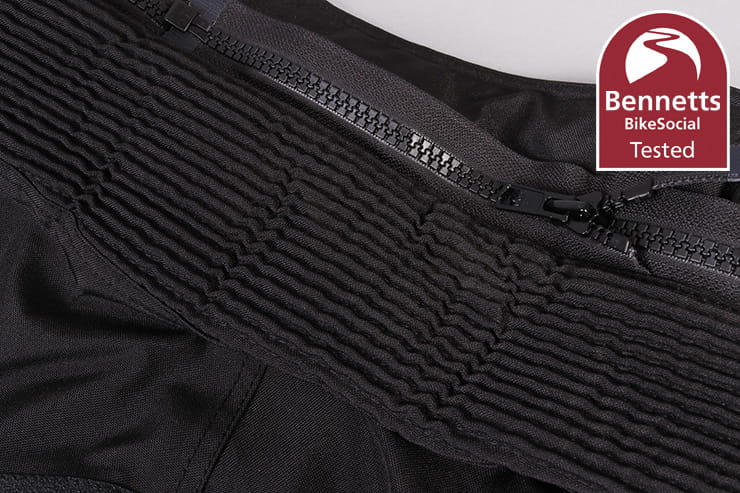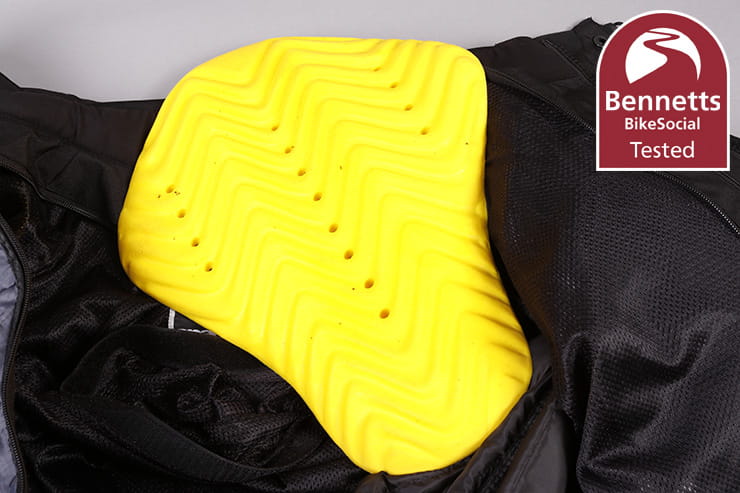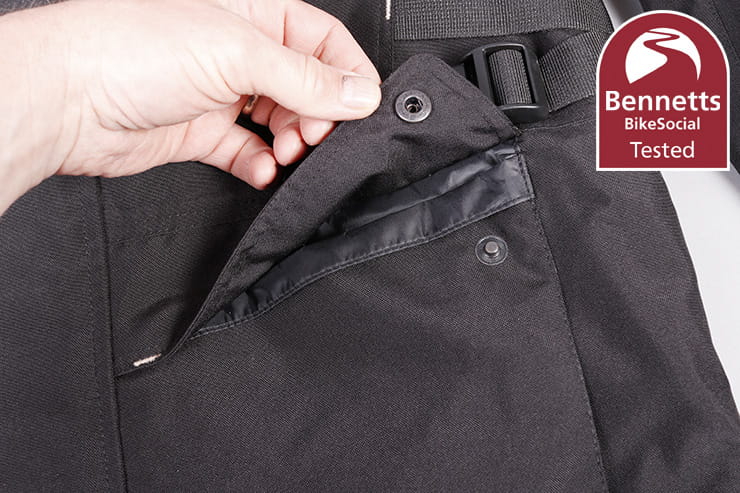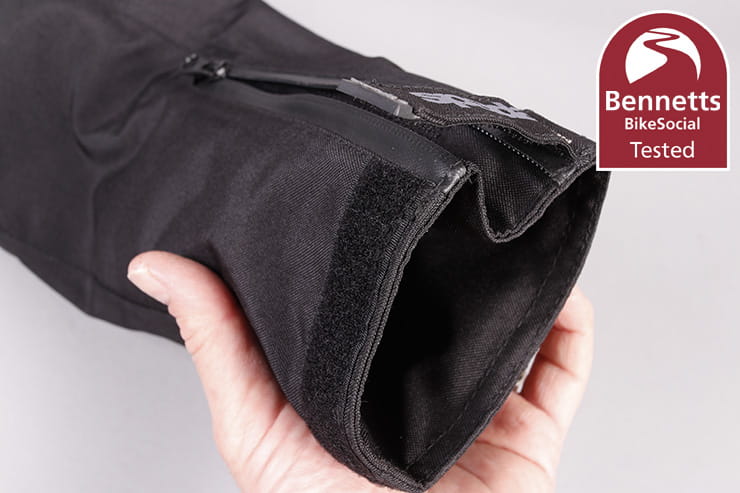Date reviewed: December 2020 | Tested by: Dave Yorke | Price: £239.99 & £189.99 | www.spadaclothing.co.uk
I’ve been using the Spada Camber jacket and trousers, which have a laminated waterproof construction, throughout most of 2020 while riding my Honda Africa Twin and the Super Soco CPX. The weather has ranged from 29°C to around 9°C and the rain has been torrential, thanks to October being the wettest one on record…
For and against
- Good waterproofing from this laminated kit
- Very reasonably priced
- Comfortable fit
- Not great ventilation
- Struggle to get gloves under the cuffs
- Small pockets
Fit
Fit is of course subjective, so always try kit on for yourself, but I normally take an XL the Spada Camber jacket fitted me exactly as expected; even with the liner in place it wasn’t too restrictive.
The sleeves are the length I think they should be, but the cuffs are a tight fit – I could get a summer gauntlet tucked into them but winter gloves meant the zip to the cuff wouldn’t close all the way.
The high neck is neoprene-lined and particularly comfortable, especially around the part directly under the chin, which doesn’t have an edge so doesn’t put any rough nylon against your skin as you move your head around, making shoulder checks more comfortable.
I found the trouser okay when stood up but as soon as I sat on the bike (or scooter) I was glad that I had a midi boot as they could rise up when I was on the Africa Twin. They’re quite roomy though, especially when the liner is out.
Protection and certification
The jacket comes with a five-piece CE-approved armour set that comprises Level 1 shoulder and elbow pads, along with a Level 2 back protector as standard. The jacket itself is rated to AA in accordance with prEN17092.
It’s the same story with the trousers offering the same levels of protection in the material and across the hip and knee protectors.
There’s a reflective strip running half way down each trouser leg along with reflective panels on the arms and along the top of the chest for added visibility.
From April 21 2018, all new motorcycle clothing is deemed to be Personal Protective Equipment (PPE). To meet this legislation, it must be tested to a recognised standard. For more information on the law, click here.
Pockets
The trousers have a waterproof pocket on each thigh that kept things dry during heavy rain, but the available opening is only 12cms long, so if you’ve got big hands you might struggle with them a bit.
The jacket has two outer pockets on the front that are accessible from either an open-to-the-elements side entry, or a waterproof inner that’s entered from the top via a storm flap. This flap is secured permanently to one side and has a pop stud on the other side. The pockets themselves are around 15cm deep.
There two internal pockets – one in front of and one behind the zip line – which are both waterproof, and if you install the lining there’s an extra pocket for a mobile phone.
Fastening
The jacket, working from the bottom up, has press studs to keep the bottom secured, a full length YKK zip and a strip of hook and loop. The zip comes with a cotton pull to make it easy for gloved hands and it’s all covered up around the – usefully high – neck.
There’s a hook to keep the neck area open on warmer days and an adjustable press-stud on the other side. I’ve got a 17-inch neck and it was on its full outward adjustment, meaning it would have struggled if my neck had been bigger.
The trousers have a waterproof zip along with a press stud and metal loop and catch to keep everything in check, and there are two zips to attach to the jacket; a short one at the back, with a longer three-quarter one that attaches directly to the Camber jacket, keeping you more secure and stopping drafts getting up the back.
Adjustment
The trousers have adjustment via a concertina section on the waistline at the top of the thigh, along with a length of hook and loop. They’re adjustable but it does mean there can be a piece of ruffled nylon that can rub on your waistline.
There’s a calf-length zip on the bottom of each leg and, along with mid-length touring boot, I also managed to get a full adventure-style boot on underneath the fabric before fully zipping it up.
The jacket has a two-setting pop stud on the bicep in case you’ve doing some gym work and a nylon strap on either side of the body to pull it in to suit.
Ventilation
The warmest day I rode in was 29°C on a 50-mile ride. Both the trousers and the jacket have two forward-facing vents that measure just 11 cm, while the jacket also has a full-width exhaust vent on the rear, between the shoulders.
Unfortunately these don’t flow anywhere near enough air, so even on mildly warm days I found myself fairly hot and uncomfortable. This isn’t that unusual in laminated kit, and it does seem clear that Spada has focussed more on the waterproofing…

Warmth and thermal liner
Both the jacket and trousers have a detachable quilted liner that’s easy enough to take in or out with one zip and a couple of press studs securing it.
It’s not thickest liner I’ve seen but thickest isn’t always the best and this did a good job of keeping me warm. Importantly, because it’s not that thick, it maintains a good fit and doesn’t really restrict movement, letting you get on with riding your bike.
The quilted liner in the trousers ends around calf level so as not to interfere with any boots.
Outer shell liner
Being polyester with a laminated membrane, the outer shell keeps the wind off, and on the majority of cooler mornings in the summer the open-mesh liner that’s fixed to the outer shell is fine. Once late autumn and winter set in, like most textile suits, I had the liner in.
Waterproofing
The Spada Camber has a laminated waterproof construction, which means the membrane is bonded to the back of the outer shell. This used to be the preserve of the premium brands because it’s traditionally been a more expensive method; most kit had a drop-liner, which sees the waterproof membrane hanging loose inside, usually fixed with small tags between the outer shell and inner liner.
When the outer shell of any garment ‘wets out’ (becomes soaked in water), the membrane finds it a lot harder to work, and you’ll get sweat building up inside, making you feel like the rain’s getting in. Bonding the membrane to the outer shell means that, while the outer can still wet out over time, it tends to dry much more quickly, so you’re more likely to have a comfortable ride home at the end of the day if you’re commuting.
The Camber is Spada’s relatively affordable laminated offering, and I wore it in some pretty substantial downpours. When I didn’t forget to ensure the vents were closed, it kept me really dry apart from a little at the front, which was because the connecting zip is a three-quarter length and so leaves a small gap where any pooled water can find its way up inside the jacket.

Spada Camber laminated jacket & trousers review: Verdict
I did find the small pocket openings, small vents and tight cuffs a bit of a let-down, and the lack of airflow on a really hot summer’s day undermines its year-round usability.
But it’s great to see decent armour coverage (with a Level 2 back protector) and an AA rating for the jacket and the trousers. Besides the water creeping up the front (which will vary depending what bike you’re sat on, as well as your build), the Spada Camber does a good job of keeping you dry, especially considering its reasonable price-point.
It might not be the best for hot days, but for the rest of the year here in the UK, I’d likely leave the liner in, forget the vents and simply enjoy it as a good-value, warm and waterproof suit.







































